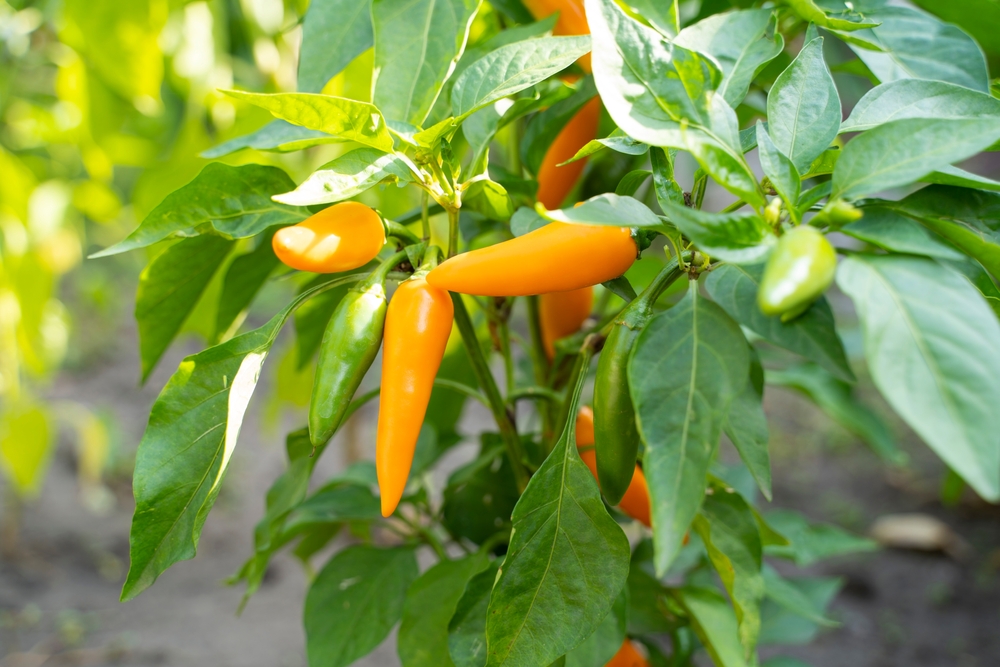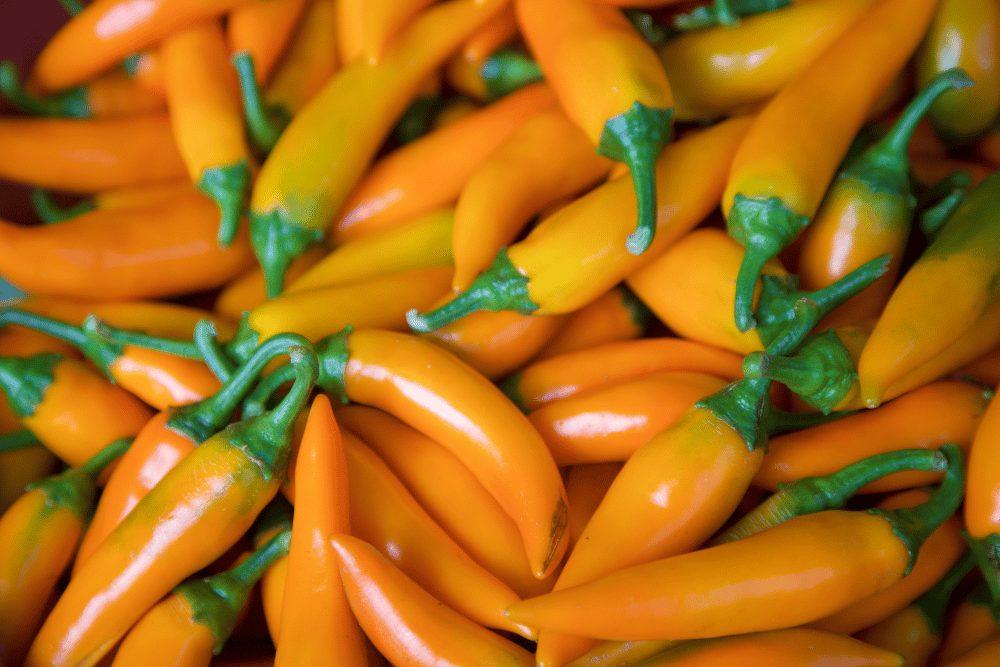Bulgarian carrot pepper is a mildly hot chile from Bulgaria. Its rich history, conical shape, delicious spice, and bright orange color make it a favorite addition to grilled meats, pizza, and omelets—and your home garden!
What Are Bulgarian Carrot Peppers?
Also known as hot carrot peppers and Shipka chiles (in some regions), the Bulgarian carrot peppers are native to Bulgaria. They are an heirloom variety of the capsicum annuum species with thick walls and a crispness that makes them excellent for pickling.
This breeding explains its beautiful orange color and habanero-like fruitiness. As the name suggests, these chiles resemble a tiny, young carrot’s shape and color. Bulgarian carrot peppers are versatile and fun to use in various meaty dishes, sauces, salsas, and vegetable salads.

Origin
According to history, carrot peppers were grown around the Black Sea and Greece before being smuggled out of the Iron Curtain to Bulgaria in the 1980s, during the cold war. Bulgarian carrot peppers are a cross between a rare Caribbean habanero and local Bulgarian peppers.
Currently, most Bulgarians prefer growing them for home use rather than commercial purposes.
Taste
In line with their cute carrot-like appearance, the pepper has a sweet, tangy taste and fruitiness similar to habanero chiles.
Texture
This color-rich pepper is thin-walled with a smooth, glossy texture. Bulgarian carrot pepper also has a unique, crispy feel that makes it ideal for eating raw or pickling.
Size
A mature hot carrot pepper is 3-4 inches long with elongated narrow pods. The pepper plant grows up to four feet tall.
Color
If you love colorful dishes, this is a great pick. Since they resemble young carrots, the hot carrot peppers have a bright, stunning orange color when fully ripened. Young chilies are dark green with creamish-white seeds.
Shape
Bulgarian peppers have a conical, curvy, tapered shape with pointed non-stem ends resembling a carrot. Its seeds are small, round, and somewhat flat.
Are Bulgarian Carrot Peppers The Same As Shipka Peppers?
Researchers are still trying to determine if Shipka and Bulgarian carrot peppers refer to the same thing.
In most cases, these two names are used interchangeably. History describes Shipka as the original name for hot carrot chiles after Caribbean habanero was bred with a local Hungarian pepper.
The pepper was named after a Bulgarian town called Shipka. Local Bulgarian people also identify the word shipka with prickly shrubs, like roses.
Since Bulgarian carrot peppers have a bright, vibrant orange color, resembling Bulgarian rose hips (shipkas), the locals started calling them Shipka peppers.
To date, these two names often refer to the same peppers. Shipka peppers and Bulgarian carrot peppers describe the spicy, bright, orange-colored Bulgarian peppers.
How Hot Is A Bulgarian Carrot Pepper?
There’s an ongoing debate about a Bulgarian carrot pepper’s heat rating. The pepper’s pungency is determined by the growing environment, cultivar, fruiting, and nitrogen/potassium content.
Some give it a heat level range of 2,500-5,000 SHUs, similar to a jalapeno pepper. In other cases, it’s rated like a hot Thai chili (50,000-100,000 SHUs) or occasionally equated in spice to a cayenne pepper (20,000-30,000 SHUs).
However, the most common heat range is 5,000-30,000 Scoville heat units on the Scoville scale. This figure means the mildest hot carrot pepper has the same heat as a hot Jalapeno chile. Cayenne is almost twice as hot as the Bulgarian carrot pepper, while habanero chili provides 12-20 times more spiciness.
How To Use Bulgarian Carrot Peppers In Cooking
The following are creative ways to use Bulgarian carrot peppers’ crunchy texture and fruity/floral taste in your cooking:
- Making Bulgarian carrot sauces – Use the peppers to make authentic Bulgarian hot sauces that are tasty and moderately spiced.
- Fresh vegetable salad – Toss thinly sliced hot carrot peppers in your fresh mixed vegetable salad for extra fruitiness, crunch, and heat.
- Pizza topping – Add some slices of Bulgarian carrot peppers to your pizza before cooking it.
- On baked bread – Use the Bulgarian carrot pepper rings to decorate and spice the top of your homemade bread, like focaccia.
- Grilled meats and seafood –Serve fresh or roasted hot carrot peppers with your grilled pork, beef, chicken, and seafood.
- Stir-fried rice and vegetables – For tangy flavor and spice, stir-fry Bulgarian carrot peppers with rice or vegetables in place of bell peppers or jalapenos.
- Salsas and chutneys – Use these carrot-shaped chiles to moderately spice salsas. Substitute the jalapeno and Fresno chiles with hot carrot peppers for a delicious chicken with chutney.
- As a hummus topping – Add thin slices of Bulgarian hot carrot chile to your humus for flavor and medium-hot spicing.

Where To Buy Bulgarian Carrot Peppers
Commercial Bulgarian carrot pepper growing is uncommon, making its supply low. However, if you’re within Europe or the western U.S., check out local farmers’ markets and grocery stores.
To guarantee a constant supply of these peppers for your recipes, you can grow the peppers in a container or in your backyard garden. Bulgarian carrot pepper seeds are available from online seed stores or Amazon.
Can You Grow Bulgarian Carrot Peppers?
Bulgarian carrot chiles are easy to grow for home use. As the peppers are open-pollinated, you can save the seeds for future use.
The chiles are best started indoors before transplanting outdoors. If you live in regions with cold, frosty climates, cover your seed container with a plastic bag to control light and warmth essential for germination, or buy a plant heating mat. Keep the soil well-drained for healthy Bulgaria carrot pepper plants and a bountiful harvest.
Substitutes For This Mild, Fruity Pepper
If you can’t find Bulgarian peppers, there are various chiles you can use instead.
Cayenne pepper is sweet and fruity like Bulgarian carrot pepper but slightly hotter. Jalapeno pepper is another excellent substitute if you don’t mind milder heat.
Serrano pepper has a comparable pungency level with hot carrot pepper with a jalapeno-like flavor profile that is great for Bulgarian carrot pepper recipes.
If you’re searching for chilies with Bulgarian carrot flavor, scotch bonnet peppers or habanero are a good fit. But expect far more heat these two.

